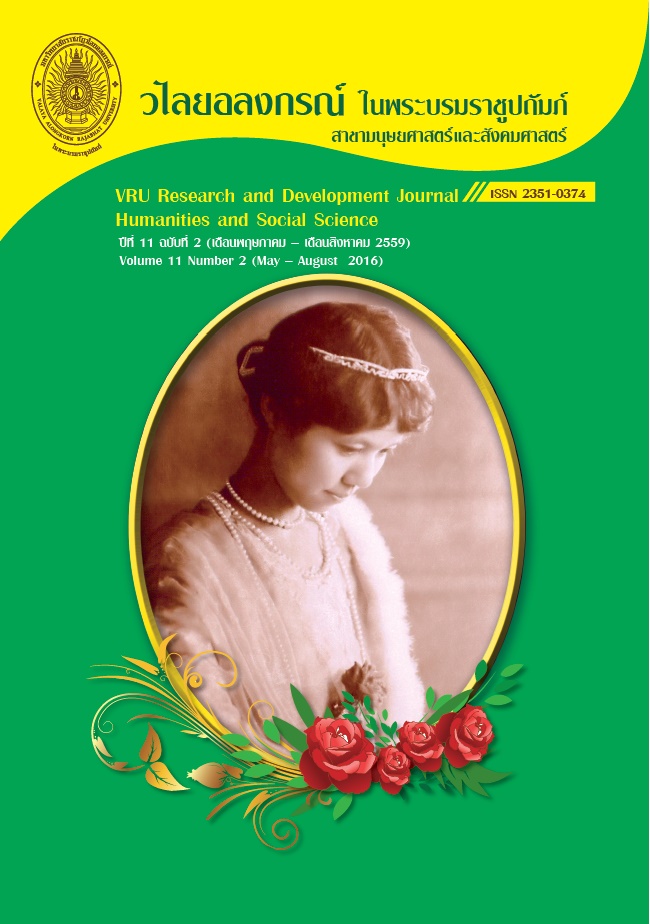การพัฒนาความคิดสร้างสรรค์ของนักศึกษาสาขาวิชาการศึกษาปฐมวัย โดยใช้แผนที่ทางความคิด
Main Article Content
Abstract
การวิจัยครั้งนี้เป็นการวิจัยเชิงปฏิบัติการในชั้นเรียนมีจุดประสงค์เพื่อเปรียบเทียบความคิดสร้างสรรค์ของนักศึกษาระดับปริญญาตรี หลักสูตรครุศาสตรบัณฑิต สาขาวิชาการศึกษาปฐมวัย ชั้นปีที่ 2 ระหว่างก่อนและหลังได้รับการจัดการเรียนรู้รายวิชาศิลปะและศิลปะประดิษฐ์โดยใช้แผนที่ทางความคิด (Mind Map) และเปรียบเทียบความคิดสร้างสรรค์ของนักศึกษาสาขาวิชาการศึกษาปฐมวัย ชั้นปีที่ 2 หลังการทดลองระหว่างกลุ่มที่ได้รับการจัดการเรียนรู้ในรายวิชาศิลปะและศิลปะประดิษฐ์โดยใช้แผนที่ทางความคิด (Mind Map) กับกลุ่มที่ได้รับการจัดการเรียนรู้ในรายวิชาศิลปะและศิลปะประดิษฐ์แบบปกติ
กลุ่มตัวอย่างที่ใช้ในการวิจัยครั้งนี้เป็นนักศึกษาชั้นปีที่ 2 สาขาวิชาการศึกษาปฐมวัย คณะครุศาสตร์ มหาวิทยาลัยราชภัฏวไลยอลงกรณ์ ในพระบรมราชูปถัมภ์ จำนวน 2 หมู่เรียน แบ่งเป็นกลุ่มทดลองซึ่งได้รับการจัดการเรียนรู้ในรายวิชาศิลปะและศิลปะประดิษฐ์โดยใช้แผนที่ทางความคิด (Mind Map) และกลุ่มเปรียบเทียบซึ่งได้รับการจัดการเรียนรู้ในรายวิชาศิลปะและศิลปะประดิษฐ์แบบปกติ
เครื่องมือที่ใช้ในการวิจัย คือ แผนการจัดการเรียนรู้ในรายวิชาศิลปะและศิลปะประดิษฐ์โดยใช้แผนที่ทางความคิด (Mind Map) และแบบทดสอบความคิดสร้างสรรค์โดยอาศัยรูปภาพเป็นสื่อเป็นสื่อแบบ ก ของทอแรนซ์ (Torrance Test of Creativity Thinking Figural Form A) วิเคราะห์ข้อมูลด้วยสถิติค่าเฉลี่ยร้อยละ ส่วนเบี่ยงเบนมาตรฐานและทดสอบสมมุติฐานด้วยสถิติทดสอบค่าที
ผลการวิจัยสรุปได้ดังนี้
1. นักศึกษากลุ่มทดลองมีคะแนนเฉลี่ยความคิดสร้างสรรค์ด้านความคิดคล่องแคล่วหลังการทดลองสูงกว่าก่อนการทดลองอย่างมีนัยสำคัญทางสถิติที่ระดับ .05
2. นักศึกษากลุ่มทดลองมีคะแนนเฉลี่ยความคิดสร้างสรรค์ด้านความคิดริเริ่มหลังการทดลองสูงกว่าก่อนการทดลองอย่างมีนัยสำคัญทางสถิติที่ระดับ .05
3. นักศึกษากลุ่มทดลองมีคะแนนเฉลี่ยความคิดสร้างสรรค์ด้านความคิดละเอียดลออหลังการทดลองสูงกว่าก่อนการทดลองอย่างมีนัยสำคัญทางสถิติที่ระดับ .05
4. นักศึกษากลุ่มทดลองมีคะแนนเฉลี่ยความคิดสร้างสรรค์ด้านความคิดคล่องแคล่วหลังการทดลองสูงกว่านักศึกษากลุ่มควบคุมอย่างมีนัยสำคัญทางสถิติที่ระดับ .05
5. นักศึกษากลุ่มทดลองมีคะแนนเฉลี่ยความคิดสร้างสรรค์ด้านความคิดริเริ่มหลังการทดลองสูงกว่านักศึกษากลุ่มควบคุมอย่างมีนัยสำคัญทางสถิติที่ระดับ .05
6. นักศึกษากลุ่มทดลองมีคะแนนเฉลี่ยความคิดสร้างสรรค์ด้านความคิดละเอียดลออหลังการทดลองสูงกว่านักศึกษากลุ่มควบคุมอย่างมีนัยสำคัญทางสถิติที่ระดับ .05
This study was experimental research. The purposes of this research were to compare creativity of second – year students which study in undergraduates bachelor of education program in early childhood education between before and after having to learn art and crafts for early childhood major based on mind map and compare creativity of second – year students after the experiment between groups that had to learn art and crafts for early childhood major based on mind map and had conventional art and crafts for early childhood instruction.
The samples were to classes of second – year students which study in bachelor of education program in early childhood education, Valaya Alongkorn Rajabhat University under the Royal Patronage. The samples were divided into two groups : an experimental group which learned art and crafts for early childhood major based on mind map and a comparative group which learned art and crafts for early childhood by conventional instruction.
The research instruments were lesson plan in art and crafts for early childhood major based on mind map and test of Torrance (Thinking Creatively with Picture Figural Form A). The collect data were analyzed by means of percentage , standard deviation and tested hypothesis by using t-test.
The research findings were summarized as follows :
- 1. After the experiment, an experimental group had an average scores in
fluency thinking ability higher than before the experiment at 0.05 level of significance.
- 2. After the experiment, an experimental group had an average scores in
originality thinking ability higher than before the experiment at 0.05 level of significance.
- 3. After the experiment, an experimental group had an average scores in
eleborational thinking ability higher than before the experiment at 0.05 level of significance.
- 4. After the experiment, an experimental group had an average scores in
fluency thinking ability higher than a comparative group at 0.05 level of significance.
5. After the experiment, an experimental group had an average scores in
originality thinking ability higher than a comparative group at 0.05 level of significance.
6. After the experiment, an experimental group had an average scores in
eleborational thinking ability higher than a comparative group at 0.05 level of significance.
Article Details
ลิขสิทธิ์บทความวิจัยที่ได้รับการตีพิมพ์เผยแพร่ในวารสารมนุษยศาสตร์และสังคมศาสตร์ วไลยอลงกรณ์ ในพระบรมราชูปถัมภ์ ถือเป็นกรรมสิทธิ์ของคณะมนุษยศาสตร์และสังคมศาสตร์ มหาวิทยาลัยราชภัฏวไลยอลงกรณ์ ในพระบรมราชูปถัมภ์ ห้ามนำข้อความทั้งหมดหรือบางส่วนไปพิมพ์ซ้ำ เว้นแต่จะได้รับอนุญาตจากมหาวิทยาลัยเป็นลายลักษณ์อักษร
ความรับผิดชอบ เนื้อหาต้นฉบับที่ปรากฏในวารสารมนุษยศาสตร์และสังคมศาสตร์ วไลยอลงกรณ์ ในพระบรมราชูปถัมภ์ เป็นความรับผิดชอบของผู้นิพนธ์บทความหรือผู้เขียนเอง ทั้งนี้ไม่รวมความผิดพลาดอันเกิดจากเทคนิคการพิมพ์
References
ชาญณรงค์ พรรุ่งโรจน์. (2546). ความคิดสร้างสรรค์. กรุงเทพฯ : สำนักพิมพ์แห่ง
จุฬาลงกรณ์มหาวิทยาลัย.
โทนี บูซาน. (2552). คัมภีร์ MIND MAP (แปลและเรียบเรียงโดยธัญญา ผลอนันต์,
นภดล จำปา). กรุงเทพฯ : ขวัญข้าว’๙๔.
สัณฑวุฒิและภัทรพล ตุลารักษ์. (2548). เด็กหัวใส Brain Child. กรุงเทพฯ. สำนักพิมพ์
ขวัญข้าว.
อารี พันธ์มณี. (2546). จิตวิทยาสร้างสรรค์การเรียนการสอน. กรุงเทพฯ : ใยไหมเอดดูเคท.
. (2549). “การจัดประสบการณ์เพื่อพัฒนเด็กปฐมวัยด้านความคิดสร้างสรรค์”
ประมวลชุดวิชาการจัดประสบการณ์สำหรับเด็กปฐมวัย หน่วยที่ 7 – 11.
นนทบุรี : โรงพิมพ์มหาวิทยาลัยสุโขทัยธรรมาธิราช.
Torrance, E.P. (1962). Guiding creative flaunt. Englewood Cliff : Prentice Hall.
Torrance, E.P. (1962). Guiding creative talent. New Jersey : Englewood Cliff
Inc..


